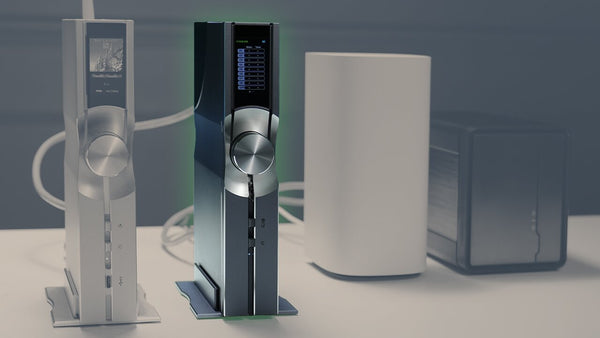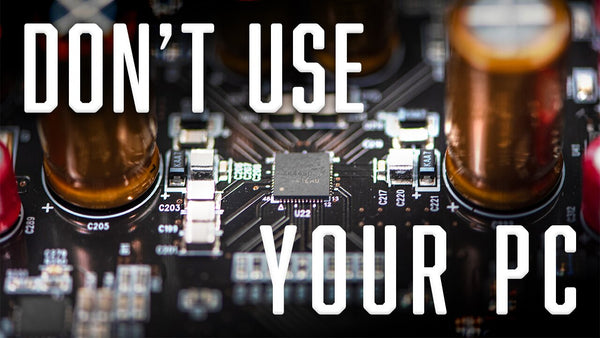How to Set Up Your Matrix Audio Element M Streamer
Read Time: Approx. 9 min.

Setting Up Your Matrix Audio Element M Streamer: A Complete Guide
Congratulations! You're the proud new owner of a Matrix Audio Element Series Streamer–But now what?
Welcome to your comprehensive setup guide for the Matrix Audio Element M/M2 Streamer. These high-quality streamers are designed to deliver exceptional digital music playback, transforming how you enjoy your music over headphones or speakers. Whether you're connecting the Element M/M2's compact design to a desktop system or integrating it into a dedicated listening room, proper setup is key to unlock their full potential.
This guide will walk you through each step of the installation process, from initial unboxing and network configuration to optimizing audio settings and navigating the MA Remote App.
About the Matrix Audio Element M/M2
Matrix Audio Element M2
With the introduction of the Element M2, Matrix Audio improved upon the Element I’s design. The Element M2 strikes a balance with the I and furthers its design elements while improving the performance and functionality of it all at a quality price point. Like other Element products, the device is packed with numerous features making it one of the most versatile music streamers on the market.
The Element M2 has a sampling rate support of up to 768 kHz and DSD up to 22.4 MHz. The Element M2 is equipped with two independent power supplies dedicated to the ARM processor and the digital audio processing part of the M2. The audio circuit part uses an independent linear power supply to present a pure music background to you.
The Element M2 is optimized for MQA decoding and rendering. MQA is a British technology that delivers the sound of an original master recording. The master file is then fully authenticated and made small enough to stream or download. The headphone amp in the Element M2 has been upgraded to a 4-channel full-balanced architecture. The fully symmetrical circuit design allows the left and right channel signals to pass through a near-perfectly symmetrical amplification circuitry. It also has an ES9028PRO DAC The ES9028PRO is a quality DAC designed to meet the demands of high quality and performance that a SABRE DAC can give, but at a more economical price point.
As sophisticated as the Element M2 is on the inside, the outside is no different. It is constructed with a double shell with the inner shell consisting of galvanized steel and the outside made of 4mm aluminum. By focusing on the materials, Matrix Audio was able to minimize the vibrations of the music player, thus reducing case resonance as well. The Element M2 is Matrix Audio’s mid-range product for the entire product line and their most cost-effective network streamer. It’s by no means a budget device and competes with some of the best music streamers on the market.
Specifications
- CPU: NXP i.MX 6Quad Cortex-A9
- DAC: ES9028PRO
- Clock Source: Crystek CCHD-950
- Digital Inputs: Coaxial, Optical, USB, IIS, LVDS, HDMI ARC
- Line Output: XLR, RCA
- Headphone Output: 4.4mm balanced, 6.35mm unbalanced
- Network: LAN (10/100/1000 Mbps), WLAN (2.4 GHz/5GHz) USB
- Tigger In: DC 6-12V <10mA
- Trigger Out: DC 12V/50mA MAX
- Controller App: MA Remote App
- Weight: 3.5kg (7.71 lbs)
- Size: 280mm W x 58mm H x 259mm D (11.02" x 2.28" x 10.20")
- Supported Formats: MP3, WMA, WAV, AIF, AIFC, AIFF, AAC, FLAC, OGG, APE, ALAC, M4A, DSF, DFF, CUE
- PCM Sampling Rate: PCM (16-24bit 44.1kHz, 48kHz, 88.2kHz, 96kHz, 176.4kHz, 192kHz, 352.8kHz, 384kHz, 705.6kHz, 768kHz) MQA (16-24Bit /44.1kHz, 48kHz, 88.2kHz, 96kHz, 176.4kHz, 192kHz, 352.8kHz, 384kHz MQA or MQA Studio stream)
- DSD Sampling Rate: DSD 2.8MHz, 5.6MHz, 11.2MHz, 22.4MHz
- Power Voltage: AC 100V-120V 50/60Hz / AC 220V-240V 50/60Hz
- Standby Power Consumption: < 5W
- Maximum Power Consumption: <50W
*Sampling Rate of PCM 768kHz / DSD 256 with Roon requires the latest A10301 firmware update. Earlier firmware versions support PCM 384kHz / DSD 128
Setup and Configuration
If setting up your device for a wireless connection, place your Element M/M2 in an open area of your home or in a location where the device will not receive interference from alternative wireless sources. For the most stable connection, we recommend setting up your Element M/M2 via a wired connection (LAN).
If you are setting up and WLAN connection, please install the antenna on the back of the Ethernet console in an upright position. If setting up a LAN connection, place an Ethernet cable into the jack located in the rear, right-hand corner of the Element console. Connect the Element M/M2 to your ISP device.
Reference the following video on how to set up your Element M/M2 Streamer to either a wired or wireless network:
Regardless of the connection configuration, download the Matrix Audio Remote application to control your Element M/M2.
Once the Matrix Audio Remote is downloaded, plug in your Element M/M2 into the power supply, power on, and wait for it to be recognized by the Matrix Audio Remote application. There are three ways to connect and configure your device in the MA remote application: WLAN, Automatic, and Manual.
Select WLAN Configuration, if you want to connect your Element M/M2 Streamer to a wireless network
Select the Automatic Connection, if your Element M/M2 has been connected to a LAN and you wish to add and search for devices automatically
Select the Manual Connection, if your device is already connected and you'd like to manually enter the device's IP address
Your basic steps in setting up your Element M/M2 for the first time:
1.) Power on. The LED indicator will turn on following the connection to the power supply. By default, the device enters Standby mode when connected to power. Pressing the Standby button on the unit body or the remote control will power on the Element M2, as signified by the LED indicator turning to a highlighted white color.
2.) Select the input source. Repeat pressing the menu button (three horizontal lines) and select the input channel selection menu. Then rotate the knob to select between auto, coaxial 1, coaxial 2, optical 1, optical 2, IIS, LVDS, USB audio, or network. Press the knob to confirm the selection. If you are unsure what input to select, choose “auto” and the device will automatically scan all digital input channels. The first connected input channel will be locked immediately. The Element M2 will continue to scan other channels until the current signal is lost. When there are several input channels being connected, the Element M2 will always choose the signal it detects first after scanning in the following order:. COAX 1 > COAX 2 > OPT1 > OPT2 > IIS LVDS > USB > Network. When using network related music sources such as AirPlay, DLNA, Roon, or MA Player, please select Network as the input channel.
3.) Select the output channel. Repeat pressing the menu button (three horizontal lines) and select the output channel selection menu. You can select output channel between balanced headphone output, single-ended headphone, and line output. Push the button to confirm your selection.
4.) Volume adjustment. The volume can be adjusted by the knob or the [speaker]- and [speaker]+ key on the remote control, and the screen will show the current volume level when adjusting. Line output and headphone output have different volume control level, as well as the line level output can be configured as a fixed level output.
Comparisons
Element I
Element X
Element P
Element M
Element I
COST
$3,419.00 USD
$2,869.00 USD
$2,049.00 USD
$1,149.00 USD
DAC
Quad-Core DAC: ES9038 PRO+ & ES9311
Quad-Core DAC: ES9028 PRO
Quad-Core DAC: ES9028 PRO
Dual-Core DAC: ES9028 PRO
USB Chip
XMOS XU216: PCM 16-24Bit 768kHz; DSD 11.2MHz (DoP); DSD 22.4MHz (Native)
XMOS XU216: PCM 16-24Bit 768kHz; DSD 11.2MHz (DoP); DSD 22.4MHz (Native)
XMOS XU216: PCM 16-24Bit 768kHz; DSD 11.2MHz (DoP); DSD 22.4MHz (Native)
XMOS XU208: PCM 16-24Bit 384kHz; DSD 5.6MHz (DoP); DSD 11.2MHz (Native)
CLOCK
Crystek CCHD-950 Ultra Low Phase Noise Femtosecond Clock
Crystek CCHD-950 Ultra Low Phase Noise Femtosecond Clock
SiTime Low Phase Noise Clock
SiTime Low Phase Noise Clock
DIGITAL INPUT
Optical (x2); Coaxial (x2); IIS LVDS (x1); USB (x1)
Optical (x2); Coaxial (x2); IIS LVDS (x1); USB (x1)
Optical (x1); Coaxial (x1); IIS LVDS (x1); USB (x1)
Optical (x1); Coaxial (x1); IIS LVDS (x1); USB (x1)
LINE OUT
RCA (x1); XLR (x1)
N/A
RCA (x1); XLR (x1)
RCA (x1); XLR (x1)
HEADPHONE OUT
4-pin XLR; Dual 3-pin XLR; 1/4" TRS (6.35mm)
(Speaker Out): x2 (230W@4ohm)
1/4" TRS (6.35mm)
1/4" TRS (6.35mm)
OUTPUT LEVEL
1/4-in: 1150mW @33ohm, 308mW @300ohm, 152mW @600ohm; XLR: 1700mW @33ohm, 1180mW @300ohm, 650mW @600ohm
N/A
1320mW @33ohm; 248mW @300ohm, 124mW @600ohm
1320mW @33ohm; 248mW @300ohm, 124mW @600ohm
NETWORK
LAN: 10BASE-T/100BASE-TX; WLAN: 2.4GHz/5GHz, IEEE 802.11 a/b/g/n/ac standard
LAN: 10BASE-T/100BASE-TX; WLAN: 2.4GHz/5GHz, IEEE 802.11 a/b/g/n/ac standard
LAN: 10BASE-T/100BASE-TX; WLAN: 2.4GHz/5GHz, IEEE 802.11 a/b/g/n/ac standard
LAN: 10BASE-T/100BASE-TX; WLAN: 2.4GHz, IEEE 802.11 a/b/g/n standard
SAMPLING RATE SUPPORT
PCM up to 768kHz; DSD up to 22.4MHz. MA Player: PCM 768kHz/DSD512; Roon: PCM 768kHz/DSD256*; DLNA: PCM 768kHz/DSD512
PCM up to 768kHz; DSD up to 22.4MHz. MA Player: PCM 768kHz/DSD512; Roon: PCM 768kHz/DSD256*; DLNA: PCM 768kHz/DSD512
PCM up to 768kHz; DSD up to 22.4MHz. MA Player: PCM 768kHz/DSD512; Roon: PCM 768kHz/DSD256*; DLNA: PCM 768kHz/DSD512
PCM up to 384kHz; DSD up to 11.2MHz. MA Player: PCM 384kHz/DSD256; Roon: PCM 384kHz/DSD128; DLNA: PCM 384kHz/DSD256
VOLUME CONTROL MODE
Hyper-Control Relays Array, Digital Volume
MUSES 72320 Resistor Divider
Digital Volume
Digital Volume
USB STORAGE
TF Card Slot (x1), USB Host (x2)
TF Card Slot (x1), USB Host (x2)
TF Card Slot (x1), USB Host (x2)
USB Host (x2)
SUPPORTED FORMATS
MP3, WMA, WAV, AIF, AIFC, AIFF, AAC, FLAC, OGG, APE, ALAC, M4A, DSF, DFF; MA Player, AirPlay/DLNA, Roon Ready, Full MQA Support, IR Remote
MP3, WMA, WAV, AIF, AIFC, AIFF, AAC, FLAC, OGG, APE, ALAC, M4A, DSF, DFF; MA Player, AirPlay/DLNA, Roon Ready, Full MQA Support, IR Remote
MP3, WMA, WAV, AIF, AIFC, AIFF, AAC, FLAC, OGG, APE, ALAC, M4A, DSF, DFF; MA Player, AirPlay/DLNA, Roon Ready, Full MQA Support, IR Remote
MP3, WMA, WAV, AIF, AIFC, AIFF, AAC, FLAC, OGG, APE, ALAC, M4A, DSF, DFF; MA Player, AirPlay/DLNA, Roon Ready, IR Remote
POWER SUPPLY
Noratel Linear 40W
Noratel Linear 25W
Linear 30W
20W AC Adapter
DIMENSIONS
13.4" x 11.1" x 2.4" (340x281×60mm)
13.4" x 11.1" x 2.4" (340x281×60mm)
10.9" x 11.1" x 2.4" (275x281×60mm)
9.5" x 8.7" x 2.2" (240x220×55mm)
WEIGHT
9.3lb (4.2kg)
10.4lb (4.7kg)
8.1lb (3.7kg)
3.3lb (1.5kg)
How-To Questions Answered
How to adjust and interpret the volume control of the Element M/M2
How to Connect Tidal and Qobuz in the MA Remote App
How to add SMB Sharing Folders on the Element M/M2
How to set cover/image settings in the Matrix Audio Remote
How to change the appearance of Matrix Audio Remote App Interface
How to push music through AirPlay or Roon on the Element M/M2
How to check for software updates on the Element M/M2
How to change the PCM filter on the Element M/M2
How to find and download the Matrix General Drivers, DSD configuration guide, and Matrix Audio Remote App
Frequency Asked Questions
How do I add my device in the Matrix Audio Remote App?
Does the Matrix Audio Element M/M2 allow for external hard drive storage?
Is the Element M/M2 Roon Compatible?
Does the Element M/M2 have a standby mode?
Does the Element M/M2 have a remote control?
What headphone connections does the Element M have?
What are the PCM filters available on the Element M?
What cloud and internet radio services are available to access directly through the Element M/M2?
What cloud and internet radio services are not available to access via the Ethernet?
How do I contact Matrix Audio if I'm having a mechanical/technical problem with the Element M?
Do I need to Install the antennas on the Element M?
Are balanced amplifiers better?
Related Videos
Hi-Fi Audio Problem Solver?
Matrix Audio Element Series Spotlight at #AXPONA
Matrix Audio Element S Review: The Most FUTUREPROOF Streamer?


















